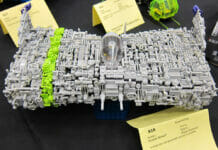This post may contains affiliate links. If you use these links to buy something we may earn a commission. Thanks.
The Block That Changed The World
LEGO has been a household name for generations. These little blocks of plastic have sparked the imaginations of children and adults alike since the 1940s.
The company was founded in Denmark by Ole Kirk Christiansen, who began producing wooden toys in 1932. After a fire destroyed his factory, he shifted focus to plastic and created the first LEGO brick in 1949.
Since then, LEGO has become a worldwide phenomenon with over 600 billion bricks produced so far. Their popularity has led to multiple theme parks, movies, and video games all centered around these small building blocks.
But what makes LEGO so special? It’s not just the nostalgia factor or the universal appeal of creating something from scratch.
The Importance of Advanced Building Techniques
What sets LEGO apart is its versatility. These simple bricks can be used alone or combined in endless ways to make virtually any creation one can imagine.
And as with any creative endeavor, there are always new techniques to be learned and mastered. This is where advanced building techniques come into play.
By pushing beyond basic stud-up models and utilizing specialized pieces, angles, and other advanced skills, builders can create truly awe-inspiring models that stand out from the crowd. In this article, we’ll explore some of these advanced techniques that will take your LEGO building skills to new heights.
Basic Building Techniques
Studs up vs studs down building
One of the most basic building techniques in LEGO is to simply stack bricks on top of each other with the studs facing up. This technique, known as “studs up” building, is the traditional way of constructing LEGO models. However, there’s also another technique called “studs down” building that involves placing bricks upside-down so that the studs face downwards.
While “studs up” building allows for a more traditional look with visible studs and a slightly raised surface, “studs down” building creates a smoother look with fewer visible studs. Additionally, using this technique can allow for greater flexibility in designing complex shapes and angles.
SNOT (Studs Not On Top) Technique
The SNOT (Studs Not On Top) technique is one of the most commonly used advanced techniques in LEGO building. It involves using pieces in a way that prevents studs from being visible on the top surface of your model. This is done by turning pieces sideways or upside-down to connect them together without exposing any studs on top.
SNOT can be used to create all sorts of shapes and angles that would otherwise be impossible using standard stacking techniques alone. By incorporating SNOT into your builds, you can create models with sleeker and more polished surfaces.
Our friends over at Tips&Bricks have covered the technique extensively and we recommend reviewing their articles
Building with Angles
Building with angles refers to utilizing bricks at different angles rather than simply stacking them straight up or down. Doing so allows builders to create more realistic curves or contours in their models, which can help bring them to life.
Angles are especially useful when creating things like vehicles or buildings where straight lines can sometimes appear too rigid or static. By adding angled pieces into your builds, you can give them a more dynamic appearance and make them stand out from other models built solely using traditional stacking techniques.
Advanced Building Techniques
Brick-Built Sculptures – Creating curves and organic shapes
While LEGO bricks are known for their square and rectangular shapes, with some creativity and skill, it’s possible to create curved and organic shapes using only basic bricks. One technique commonly used is called “cheese slope layering.” This involves stacking small slopes on top of each other at different angles to create a smooth curve.
Another method is called “brick bending,” where you heat up a brick in hot water or with a hair dryer, then carefully shape it into the desired curve before letting it cool down. To bring more realism to brick-built sculptures, specialized pieces can also be used.
The largest of these are the “Big Ben Bricks,” which are 4 times the size of regular LEGO bricks. There are also many smaller specialized pieces like arches, curving slopes, and hinge plates that can be used creatively for a range of shapes.
Microscale Building – Creating miniature models with intricate details
Microscale building is all about creating tiny models that still capture all the details of their larger counterparts. To achieve this level of detail, builders often use small or rare pieces like 1×1 tiles or tiny clips to add texture or create intricate designs on a small scale.
Forced perspective techniques are also common in microscale building. By placing smaller objects further away from the viewer and larger objects closer up, builders can create an illusion of depth in a small space.
Modular Buildings – Creating large-scale structures in sections that can be combined and rearranged

Modular building is popular among LEGO enthusiasts who enjoy creating large-scale structures like cityscapes or castles that can be taken apart and rearranged in different ways. To build modularly, builders plan each section as its own independent unit that can connect with other modules through standardized connectors.
Interior details can also be incorporated into modular buildings, creating a more immersive and realistic experience. These interior designs can range from furniture and appliances to entire rooms or floors.
Technic Building – Incorporating gears, motors, and other mechanical elements into builds
Technic building involves incorporating gears, motors, and other mechanical elements into LEGO builds to create functional models like vehicles or robots. These specialized pieces allow builders to create complex machines with movable parts that can be controlled by hand or by remote control.
One popular technique in technic building is called “Power Functions,” which uses small electric motors that can be controlled by a remote control unit. With Power Functions, builders can create models with working lights, moving parts, and even powered wheels that allow their creations to move under their own power.
Rarely Known Small Details
Color Matching
When building with LEGO, color matching can make a big difference in the overall look of your creation. However, it’s not always easy to find the exact shade you need. Did you know that there are over 60 different colors available in LEGO bricks?
It can be overwhelming to keep track of them all. One way to ensure color consistency is to buy bricks from the same set or series.
LEGO often releases themed sets that feature a specific color scheme, making it easier to find matching pieces. Another option is to use online resources like Bricklink, which allows you to search for specific colors and buy pieces from sellers around the world.
Minifigure Customization
Minifigures are an essential part of any LEGO creation, but sometimes they don’t quite fit the vision you have in mind. That’s where customization comes in! Did you know that you can mix and match minifigure parts from different sets to create unique characters?
To take customization even further, try using custom decals or painting minifigure parts with acrylic paint (water-based). There are also third-party websites that sell custom minifigure parts and accessories if you’re looking for something truly unique.
Brick Separators
Have you ever struggled with removing two tightly connected LEGO bricks? It can be frustrating and often leads to sore fingers or damaged bricks. But fear not!
The solution is a small tool called a brick separator. These handy gadgets come included in many larger LEGO sets and make separating bricks a breeze.
Simply place the separator between two connected bricks and twist gently until they come apart. You’ll wonder how you ever lived without one!
Beyond their intended use, the brick separator can make amusing additions to mocs and stand in for various other items. Our friends over at Tips&Bricks again have several articles on this topic.
Overall, while these small details may seem insignificant at first glance, they can make a big difference in your LEGO building experience. Whether it’s finding the perfect shade of blue, creating a custom minifigure, or using a brick separator to save your fingers, paying attention to the small details can elevate your builds to new levels of creativity and precision.
Conclusion
Recap of Advanced Building Techniques Covered in the Article
Throughout this article, we have covered a variety of advanced LEGO building techniques that will take your creations to the next level. We explored basic building techniques such as studs up vs. studs down, SNOT (Studs Not On Top), and building with angles.
Then we moved on to more advanced techniques such as brick-built sculptures, microscale building, modular building, and technic building. We also discussed some rarely known small details such as color matching, minifigure customization, and brick separators.
With these techniques at your disposal, you can create anything from a majestic castle to a fully-functional robot. You can build intricate details into your models using forced perspective and color blending.
You can create modular buildings that fit together seamlessly or vehicles that actually move. The possibilities are endless!
Encouragement to Experiment with New Techniques and Push the Limits of LEGO Building Creativity
Now that you have learned some new techniques for advancing your LEGO-building skills, it’s time to put them into practice! Don’t be afraid to experiment with new styles and push yourself out of your comfort zone. The beauty of LEGO is that it allows you to build whatever you want in any way you want.
There are no rules or limitations other than your own imagination. So go ahead and let your creativity run wild!
Try combining different techniques or inventing a new one altogether. Who knows what amazing things you’ll come up with?
Remember – the joy of LEGO is in the process just as much as the final product. Enjoy every moment of creating something new and unique!
Cover Photo by FORTYTWO on Unsplash
Consider supporting Brick Brains by purchasing your LEGO from LEGO.com using our affiliate links.
We get a small percentage of the purchase total and it doesn’t change the price you pay.











